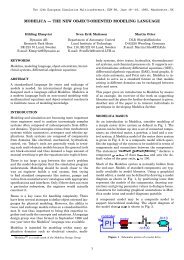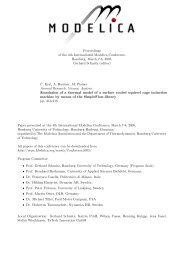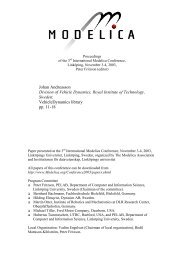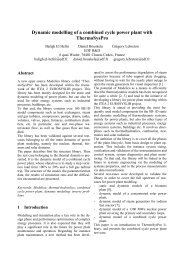Modelling Automotive Hydraulic Systems using the Modelica ...
Modelling Automotive Hydraulic Systems using the Modelica ...
Modelling Automotive Hydraulic Systems using the Modelica ...
You also want an ePaper? Increase the reach of your titles
YUMPU automatically turns print PDFs into web optimized ePapers that Google loves.
Abstract<br />
<strong>Modelling</strong> <strong>Automotive</strong> <strong>Hydraulic</strong> <strong>Systems</strong> <strong>using</strong> <strong>the</strong> <strong>Modelica</strong><br />
Actuation<strong>Hydraulic</strong>s Library<br />
This paper describes applications in <strong>the</strong> automotive<br />
industry which require modelling and simulation of<br />
hydraulic systems and introduces a new library developed<br />
specifically for use in <strong>the</strong>se applications.<br />
Issues encountered whilst modelling hydraulic systems<br />
are discussed, from <strong>the</strong> numerical issues of<br />
simulating mixed hydraulic-mechanical systems to<br />
<strong>the</strong> more practical aspects such as <strong>the</strong> availability of<br />
parameter data for valve models.<br />
A selection of case studies are described.<br />
Keywords: hydraulics, automotive, power steering,<br />
transmission actuation, lubrication, braking systems,<br />
active 4wd<br />
1 Introduction<br />
<strong>Modelling</strong> <strong>Automotive</strong> <strong>Hydraulic</strong> <strong>Systems</strong> <strong>using</strong> <strong>the</strong> <strong>Modelica</strong> Actuation<strong>Hydraulic</strong>s Library<br />
An increasing number of automotive systems use<br />
some form of electro-hydraulic control, and with<br />
increasing levels of complexity in <strong>the</strong>se devices<br />
simulation is an important part of <strong>the</strong> development<br />
process. <strong>Modelica</strong> provides an ideal environment for<br />
such simulation as it is necessary to include mechanical,<br />
electrical and hydraulic components in <strong>the</strong><br />
same system, utilising <strong>Modelica</strong>’s multi-domain capabilities.<br />
2 Applications of <strong>Hydraulic</strong>s Simulation<br />
in <strong>Automotive</strong> Industry<br />
Key applications of hydraulics within automotive<br />
engineering are in <strong>the</strong> power steering, transmission,<br />
driveline and braking systems.<br />
Peter Harman<br />
Ricardo UK Ltd.<br />
Leamington Spa, UK<br />
Peter.Harman@ricardo.com<br />
2.1 Power Assisted Steering<br />
Power steering is standard on virtually every road<br />
car, racing car and off-highway vehicle, and in <strong>the</strong><br />
majority of cases is a hydraulic system. A spool<br />
valve, ei<strong>the</strong>r translational or rotational, translates <strong>the</strong><br />
deflection of <strong>the</strong> steering wheel relative to <strong>the</strong> steering<br />
rack into a hydraulic flow into a piston to provide<br />
additional steering force. The dynamics of <strong>the</strong> hydraulic<br />
system affect <strong>the</strong> response of <strong>the</strong> vehicle to<br />
<strong>the</strong> driver input and <strong>the</strong>refore simulation is used to<br />
predict <strong>the</strong> effect of parameter changes such as <strong>the</strong><br />
spool geometry.<br />
Figure 1: Power steering spool valve model<br />
Figure 1 shows a <strong>Modelica</strong> model of a spool valve<br />
within a power steering system model. The spool<br />
model is built up of submodels, each representing<br />
one flow path through <strong>the</strong> valve. These “SpoolPort”<br />
models interface with translational mechanics components<br />
from <strong>the</strong> <strong>Modelica</strong> standard library, and <strong>the</strong><br />
flow through each is a function of <strong>the</strong> spool displacement,<br />
<strong>the</strong> pressure drop and <strong>the</strong> port geometry.<br />
The <strong>Modelica</strong> Association <strong>Modelica</strong> 2006, September 4 th – 5 th<br />
399
P.A. Harman<br />
This makes it easy to quickly build complex spool<br />
arrangements for this type of application.<br />
2.2 Transmission Actuation and Lubrication<br />
The trend in transmission technology is towards actuated<br />
transmissions such as Automated Manual<br />
Transmissions (AMT) and Dual-Clutch Transmissions<br />
(DCT or DSG), and <strong>the</strong>se plus <strong>the</strong> continuation<br />
of development of conventional Automatic Transmissions<br />
and Continuously Variable Transmissions<br />
(CVT) lead to an overall growth in hydraulically actuated<br />
systems. Development of valve-blocks and <strong>the</strong><br />
control system requires combined simulation of <strong>the</strong><br />
hydraulics and <strong>the</strong> transmission dynamics [1]. These<br />
transmissions often also have lubrication systems<br />
combined for which simulation is required to determine<br />
flows at each outlet.<br />
2.3 Driveline Control and Braking <strong>Systems</strong><br />
Active four wheel drive systems and Torque Vectoring<br />
systems for <strong>the</strong> enhancement of vehicle dynamics<br />
are increasingly popular. Development of <strong>the</strong>se<br />
systems requires combined simulation of driveline<br />
components and vehicle dynamics, [2], and fur<strong>the</strong>r<br />
extending this with models of <strong>the</strong> hydraulic system<br />
allows <strong>the</strong> effect of hydraulic dynamics on <strong>the</strong> vehicle<br />
behaviour to be studied.<br />
Likewise <strong>the</strong> effect of antilock braking systems and<br />
brake force distribution on vehicle dynamics can be<br />
studied.<br />
3 Issues with <strong>Hydraulic</strong> Simulation<br />
A library previously developed [3] in Simulink has<br />
been successfully used for a number of projects, but<br />
requires an expert user. Lessons learnt from this<br />
work which have been applied in <strong>the</strong> Actuation<strong>Hydraulic</strong>s<br />
library include accounting for numerical<br />
issues and <strong>the</strong> availability of parameter data.<br />
3.1 Numerical Issues<br />
Numerical issues in hydraulic simulation are well<br />
discussed in [4], small volumes around valves lead to<br />
numerically stiff systems and non-linear systems of<br />
equations containing discontinuities arise due to in-<br />
terconnected components with non-return valves and<br />
shuttle valves. These characteristics exploit well <strong>the</strong><br />
capabilities of <strong>Modelica</strong>.<br />
3.2 Data Availability<br />
The ideal source of data is a disassembled component<br />
as in figure 2, as specifying orifice areas for<br />
valves is not necessarily compatible with <strong>the</strong> data<br />
made available by manufacturers. Data for hydraulic<br />
components is available in a wide range of forms,<br />
such as flow areas, lookup tables of flow against<br />
pressure or special forms such as <strong>the</strong> Lohm unit devised<br />
by Lee <strong>Hydraulic</strong>s. The Actuation<strong>Hydraulic</strong>s<br />
library uses “replaceable” flow-models for orifice<br />
flows, each compatible class defines flow as a function<br />
of pressure drop and parameters according to <strong>the</strong><br />
data available.<br />
Figure 2: Typical hydraulic spool<br />
For some components a pressure drop across <strong>the</strong><br />
component is <strong>the</strong> only data available. With some<br />
modelling tools it would be necessary to reverseengineer<br />
an orifice size and flow coefficient to<br />
achieve this pressure drop. However <strong>the</strong> Actuation-<br />
<strong>Hydraulic</strong>s library exploits <strong>the</strong> acausal capabilities of<br />
<strong>Modelica</strong> and allows <strong>the</strong> choice of a flow-model<br />
where pressure drop is specified as a function of<br />
flow.<br />
4 Actuation<strong>Hydraulic</strong>s Library<br />
The modelling library was developed specifically for<br />
<strong>the</strong> applications described and with <strong>the</strong> aim of overcoming<br />
<strong>the</strong> issues described. Although hydraulics<br />
libraries in <strong>Modelica</strong> already existed [5,6,7], <strong>the</strong>se<br />
were ei<strong>the</strong>r unavailable or did not fulfil all <strong>the</strong> needs<br />
of <strong>the</strong> target applications.<br />
The library components are iso<strong>the</strong>rmal, <strong>the</strong> effects of<br />
temperature can be studied by running <strong>the</strong> models<br />
with different fluid parameters, but <strong>the</strong>rmodynamic<br />
effects within <strong>the</strong> fluid are not taken into account.<br />
The <strong>Modelica</strong> Association <strong>Modelica</strong> 2006, September 4 th – 5 th<br />
400
All components in <strong>the</strong> library extend from a base<br />
class, Partial<strong>Hydraulic</strong>Component, which defines an<br />
“outer” instance of <strong>Hydraulic</strong>sGlobal. This allows<br />
<strong>the</strong> fluid used in <strong>the</strong> model to be selected in one location<br />
and works in a similar manner to <strong>the</strong> “World”<br />
component within <strong>the</strong> <strong>Modelica</strong> MultiBody library.<br />
A wide range of components are included in <strong>the</strong> library,<br />
including valves, pipes, accumulators, pumps<br />
and actuators.<br />
4.1 Valves<br />
As described earlier, complex spool arrangements<br />
can be modelled, with variation of parameters as illustrated<br />
in figure 3. Flow through spools utilise <strong>the</strong><br />
improved flow formula described in [8].<br />
Spring rates Effect of spool geometry<br />
on valve dynamics<br />
Port overlap / underlap<br />
Pilot area<br />
Figure 3: Modifiable parameters for spool modelling<br />
Simple valves are modelled <strong>using</strong> <strong>the</strong> data available<br />
as described earlier. A range of simple valve types<br />
such as non-return valves are included.<br />
4.2 Pipes and Accumulators<br />
Models of pipe flow including inertia, compressibility<br />
and friction effects, including pipe wall expansion<br />
[9], are included. Lumped or distributed models can<br />
be used depending on <strong>the</strong> level of detail required.<br />
Gas-charged and spring-charged accumulator models<br />
are also included.<br />
4.3 Pumps<br />
<strong>Modelling</strong> <strong>Automotive</strong> <strong>Hydraulic</strong> <strong>Systems</strong> <strong>using</strong> <strong>the</strong> <strong>Modelica</strong> Actuation<strong>Hydraulic</strong>s Library<br />
The pump and motor models include volumetric<br />
losses due to leakages and compressibility, and mechanical<br />
losses due to friction and inertia. Variable<br />
swashplate models are included, as shown in figure<br />
4.<br />
Figure 4: Diagram and Icon of Variable Swashplate<br />
Pump model<br />
Flow ripple due to <strong>the</strong> number of pistons, teeth or<br />
lobes in <strong>the</strong> pump can be included, this can be useful<br />
for analysing noise and vibration aspects of hydraulic<br />
systems and ensuring volumes around pumps<br />
provide enough damping of <strong>the</strong>se vibrations. Figure<br />
5 shows <strong>the</strong> different magnitudes and frequencies of<br />
ripple for different pump configurations.<br />
Figure 5: Pump flow ripple against angle for range of<br />
pumps with different numbers of pistons / lobes<br />
4.4 Actuators<br />
Translational and rotary actuators with inertia, friction,<br />
fluid compressibility and leakage effects are<br />
included.<br />
The <strong>Modelica</strong> Association <strong>Modelica</strong> 2006, September 4 th – 5 th<br />
401
P.A. Harman<br />
Actuator, pump and spool components all interface<br />
with <strong>the</strong> <strong>Modelica</strong> standard library mechanics components,<br />
allowing connection to mechanical models<br />
from o<strong>the</strong>r libraries. Current signals to valves are<br />
applied <strong>using</strong> interfaces from <strong>the</strong> Blocks package<br />
within <strong>the</strong> standard library.<br />
5 Case Studies<br />
These case studies are recent typical uses of <strong>the</strong> library.<br />
5.1 Continuously Variable Transmission<br />
The most common form of Continuously Variable<br />
Transmission (CVT) utilises hydraulic actuators on<br />
conic “variators” to control <strong>the</strong> radius of a belt on<br />
ei<strong>the</strong>r variator.<br />
A CVT of this design was simulated <strong>using</strong> <strong>the</strong> Actuation<strong>Hydraulic</strong>s<br />
library in order to identify solutions<br />
to improve <strong>the</strong> poor controllability of <strong>the</strong> pressure<br />
at <strong>the</strong> primary variator. The relationship between<br />
current duty ratio at <strong>the</strong> solenoid valve and <strong>the</strong><br />
pressure at <strong>the</strong> variator was validated against test<br />
data.<br />
A parameter study was performed for spring rates<br />
and port overlaps in <strong>the</strong> main spool valve, resulting<br />
in a 100% increase in duty ratio range over which<br />
pressure is controlled and 25% reduction in hysteresis.<br />
Increased Range<br />
Reduced Hysteresis<br />
Figure 6: Increased controllability of CVT<br />
5.2 Dual Clutch Transmission<br />
Simulation <strong>using</strong> <strong>the</strong> Actuation<strong>Hydraulic</strong>s library<br />
was performed on <strong>the</strong> actuation and lubrication systems<br />
for <strong>the</strong> 750Nm 7 Speed Dual Clutch Transmission<br />
developed for <strong>the</strong> Chrysler ME4-12 vehicle.<br />
Figure 7: Chrysler ME4-12 with Ricardo DCT<br />
A key aim during design of <strong>the</strong> transmission was to<br />
minimise complexity and cost of <strong>the</strong> hydraulic system<br />
in order show a transmission suitable for mass<br />
production. One result of this was <strong>the</strong> use of a shared<br />
pump between <strong>the</strong> lubrication system and <strong>the</strong> gearshift<br />
actuation system. The sizing of <strong>the</strong> pump and<br />
The <strong>Modelica</strong> Association <strong>Modelica</strong> 2006, September 4 th – 5 th<br />
402
accumulator needed to be sufficient to allow <strong>the</strong> vehicle<br />
to change gear sequentially from 7 th through to<br />
1 st whilst undergoing maximum deceleration at <strong>the</strong><br />
minimum engine speed and hence minimum pump<br />
flow. It also had to provide enough lubrication flow<br />
to each of <strong>the</strong> bearings in <strong>the</strong> transmission.<br />
Pressure / bar<br />
2.8<br />
2.6<br />
2.4<br />
2.2<br />
2<br />
1.8<br />
1.6<br />
1.4<br />
1.2<br />
1<br />
6000<br />
5000<br />
4000<br />
3000<br />
Engine Speed / rpm<br />
2000<br />
1000<br />
0 0<br />
5<br />
10<br />
15<br />
20<br />
25<br />
30<br />
1LubeCircuit1.SprayBar4.flows[1]<br />
2LubeCircuit1.SprayBar4.flows[2]<br />
3LubeCircuit1.SprayBar4.flows[3]<br />
4LubeCircuit1.SprayBar4.flows[4]<br />
5LubeCircuit1.DiffHo<strong>using</strong>.flows[1]<br />
6LubeCircuit1.DiffHo<strong>using</strong>.flows[2]<br />
7LubeCircuit1.ReverseIdlerMesh.flows[1]<br />
8LubeCircuit1.SprayBar2.flows[3]<br />
9LubeCircuit1.SprayBar2.flows[2]<br />
10LubeCircuit1.SprayBar2.flows[1]<br />
11LubeCircuit1.ReverseIdlerShaft.flows[1]<br />
12LubeCircuit1.SprayBar1.flows[2]<br />
13LubeCircuit1.SprayBar1.flows[1]<br />
14LubeCircuit1.OutputShaftCentreBearings.flows[2]<br />
15LubeCircuit1.OutputShaftCentreBearings.flows[1]<br />
16LubeCircuit1.TaperBearings.flows[2]<br />
17LubeCircuit1.TaperBearings.flows[1]<br />
18LubeCircuit1.DiffSupportBearings.flows[2]<br />
19LubeCircuit1.DiffSupportBearings.flows[1]<br />
20LubeCircuit1.SprayBar3.flows[1]<br />
21LubeCircuit1.SprayBar3.flows[2]<br />
22LubeCircuit1.SprayBar3.flows[3]<br />
23LubeCircuit1.SprayBar3.flows[4]<br />
24LubeCircuit1.SprayBar3.flows[5]<br />
25LubeCircuit1.SprayBar3.flows[6]<br />
26LubeCircuit1.SprayBar3.flows[7]<br />
27LubeCircuit1.OutputShaft.flows[1]<br />
28LubeCircuit1.OutputShaft.flows[2]<br />
29LubeCircuit1.InputShaft.flows[1]<br />
30LubeCircuit1.InputShaft.flows[2]<br />
31LubeCircuit1.SpiralBevel.flows[1]<br />
32LubeCircuit1.SpiralBevel.flows[2]<br />
33LubeCircuit1.SprayBar4.flows[5]<br />
34LubeCircuit1.SprayBar4.flows[6]<br />
35LubeCircuit1.SprayBar4.flows[7]<br />
Figure 8: Lubrication flow against shaft speed at<br />
each bearing<br />
The simulation was used, toge<strong>the</strong>r with optimisation<br />
techniques, to define <strong>the</strong> pump and accumulator sizes<br />
and <strong>the</strong> sizes of each hole in <strong>the</strong> lubrication spray<br />
bars.<br />
5.3 Formula 1 <strong>Hydraulic</strong>s<br />
Calculation of component sizes for F1 hydraulics is<br />
not a straightforward task as <strong>the</strong> pump and accumulator<br />
provide fluid for <strong>the</strong> gearshift, clutch, throttle,<br />
differential, power steering and fuel flap. A solution<br />
for this and control system testing and development<br />
has been provided by <strong>using</strong> <strong>Modelica</strong> simulation<br />
models which can ei<strong>the</strong>r connect to race simulations<br />
or be driven by replays of test data, allowing engineers<br />
to study <strong>the</strong> effects of parameter changes.<br />
6 Conclusions<br />
<strong>Modelling</strong> <strong>Automotive</strong> <strong>Hydraulic</strong> <strong>Systems</strong> <strong>using</strong> <strong>the</strong> <strong>Modelica</strong> Actuation<strong>Hydraulic</strong>s Library<br />
The Actuation<strong>Hydraulic</strong>s library provides a solution<br />
for all automotive hydraulics applications, with connectivity<br />
to o<strong>the</strong>r <strong>Modelica</strong> packages. Successful use<br />
of <strong>the</strong> library has been shown for a number of applications.<br />
35<br />
References<br />
[1] Brandao, F., Harman, P., “An Integrated<br />
Approach: Ricardo Transmission<br />
and Driveline Simulation Library”,<br />
IMechE IPDS 2006<br />
[2] Brandao, F., Barnbrook, R., Shuttlewood,<br />
D., “An Integrated Approach<br />
Using IPG CarMaker amd Dymola<br />
for Transmission and Driveline<br />
[3]<br />
<strong>Modelling</strong>”, IPG User Conference<br />
2006<br />
Harman, P., “Dynamic Analysis of<br />
Transmission <strong>Hydraulic</strong> <strong>Systems</strong>”,<br />
2004, Ricardo Technical Support<br />
Agreement (TSA) presentation<br />
[4] “IMAGINE SA Technical Bulletin<br />
114: Numerical Challenges posed by<br />
Modeling <strong>Hydraulic</strong> <strong>Systems</strong>”, 2000<br />
[5] Beater, P., Otter, M., “Multi-Domain<br />
Simulation: Mechanics and <strong>Hydraulic</strong>s<br />
of an Excavator”, Proceedings of<br />
<strong>the</strong> 3 rd International <strong>Modelica</strong> Conference<br />
2003<br />
[6] Tiller, M., “Development of a Simplified<br />
Transmission <strong>Hydraulic</strong>s Library<br />
based on <strong>Modelica</strong>.Fluid”,<br />
Proceedings of <strong>the</strong> 4 th International<br />
<strong>Modelica</strong> Conference 2005<br />
[7] Beater, P., “Modeling and Digital<br />
Simulation of <strong>Hydraulic</strong> <strong>Systems</strong> in<br />
Design and Engineering Education<br />
<strong>using</strong> <strong>Modelica</strong> and HyLib”, <strong>Modelica</strong><br />
Workshop 2000<br />
[8] Ellman, A., Piche, R., “A Modified<br />
Orifice Flow Formula for Numerical<br />
Simulation of Fluid Power <strong>Systems</strong>”,<br />
[9] Watton, J., “Fluid Power <strong>Systems</strong>”,<br />
Prentice Hall, 1989<br />
The <strong>Modelica</strong> Association <strong>Modelica</strong> 2006, September 4 th – 5 th<br />
403

















